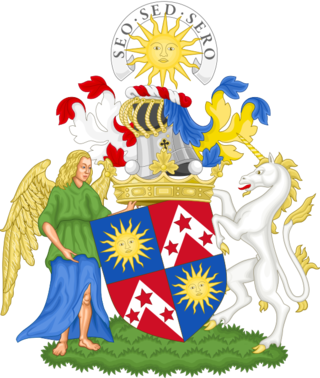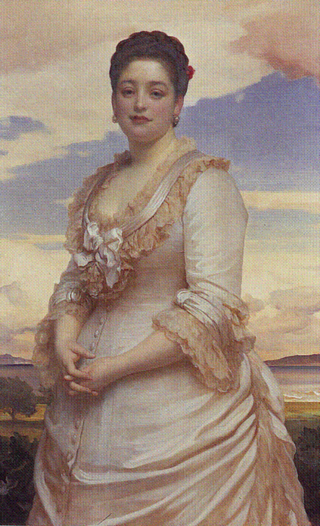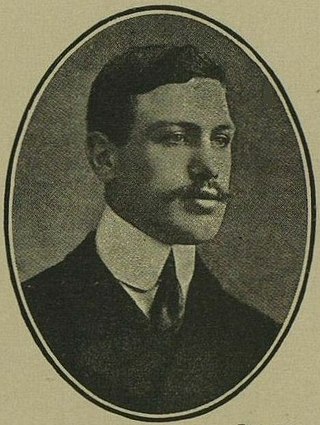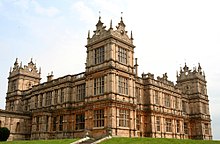
Archibald Philip Primrose, 5th Earl of Rosebery, 1st Earl of Midlothian, was a British Liberal Party politician who served as Prime Minister of the United Kingdom from March 1894 to June 1895. Between the death of his father, in 1851, and the death of his grandfather, the 4th Earl of Rosebery, in 1868, he was known by the courtesy title of Lord Dalmeny.

Marquess of Lothian is a title in the Peerage of Scotland, which was created in 1701 for Robert Kerr, 4th Earl of Lothian. The Marquess of Lothian holds the subsidiary titles of Earl of Lothian, Earl of Lothian, Earl of Ancram (1633), Earl of Ancram, Viscount of Briene (1701), Lord Newbattle (1591), Lord Jedburgh (1622), Lord Kerr of Newbattle (1631), Lord Kerr of Nisbet, Langnewtoun, and Dolphinstoun (1633), Lord Kerr of Newbattle, Oxnam, Jedburgh, Dolphinstoun and Nisbet (1701), and Baron Ker, of Kersheugh in the County of Roxburgh (1821), all but the last in the Peerage of Scotland. As The Lord Ker in the Peerage of the United Kingdom, previous marquesses sat in the House of Lords before 1963, when Scottish peers first sat in the House of Lords in their own right. The holder of the marquessate is also the Chief of Clan Kerr.

Earl of Stair is a title in the Peerage of Scotland. It was created in 1703 for the lawyer and statesman John Dalrymple, 2nd Viscount of Stair.

Earl of Halifax is a title that has been created four times in British history—once in the Peerage of England, twice in the Peerage of Great Britain, and once in the Peerage of the United Kingdom. The name of the peerage refers to Halifax, West Yorkshire.

Earl of Gosford is a title in the Peerage of Ireland. It was created in 1806 for Arthur Acheson, 2nd Viscount Gosford.

Earl of Rosslyn is a title in the Peerage of the United Kingdom. It was created in 1801 for Alexander Wedderburn, 1st Baron Loughborough, Lord Chancellor from 1793 to 1801, with special remainder to his nephew Sir James St Clair-Erskine, as Wedderburn had no surviving issue of his own. Wedderburn had already been created Baron Loughborough, of Loughborough in the County of Leicester, in the Peerage of Great Britain in 1780, with normal remainder to the heirs male of his body, and Baron Loughborough, of Loughborough in the County of Surrey, in the Peerage of Great Britain in 1795, with the same remainder as the earldom. The 1780 barony became extinct upon his death, but the 1795 barony and the earldom passed, by the special remainder, to his nephew, who thus became the second Earl of Rosslyn. The second Earl was a Lieutenant-General in the Army and also held political office as Lord Privy Seal and Lord President of the Council.

Hannah Primrose, Countess of Rosebery was the daughter of Baron Mayer de Rothschild and his wife Juliana. After inheriting her father's fortune in 1874, she became the richest woman in Britain. In 1878, Hannah de Rothschild married Archibald Primrose, 5th Earl of Rosebery, and was thereafter known as the Countess of Rosebery.

Albert Edward Harry Meyer Archibald Primrose, 6th Earl of Rosebery, 2nd Earl of Midlothian,, styled Lord Dalmeny until 1929, was a British liberal politician who briefly served as Secretary of State for Scotland in 1945. He was the Member of Parliament for Midlothian from 1906 to 1910. He became the Earl of Rosebery and Midlothian in 1929 and was thus a member of the House of Lords until his death.
Archibald John Primrose, 4th Earl of Rosebery,, styled Viscount Primrose until 1814, was a British politician.
Archibald Primrose, 1st Earl of Rosebery PC was a Scottish politician.
Neil Archibald Primrose, 7th Earl of Rosebery, 3rd Earl of Midlothian, styled Lord Primrose between 1931 and 1974, is a Scottish nobleman. He was a member of the House of Lords from 1974 to 1999. His son and heir is Harry Primrose, Lord Dalmeny.

Sir Archibald Primrose, 1st Baronet, Lord Carrington was a notable Scottish lawyer, judge, and Cavalier.
Archibald Primrose, Lord Dalmeny, was a British Whig politician.

Clan Primrose is a Lowland Scottish clan.
Viscount of Primrose was a title in the Peerage of Scotland. It was created in 1703 for Sir James Primrose, 3rd Baronet, along with the subsidiary title Lord Primrose and Castlefield. He was the grandson of Archibald Primrose, a Lord of Session under the title Lord Carrington, who in 1651 was created a Baronet, of Carrington in the County of Selkirk, in the Baronetage of Nova Scotia. The peerages became extinct on the death of the third Viscount in 1741. However, the baronetcy was passed on to the late Viscount's cousin James Primrose, 2nd Earl of Rosebery, who became the fifth Baronet of Carrington. He was the son of Archibald Primrose, 1st Earl of Rosebery, fourth son of Sir Archibald Primrose, 1st Baronet. For further history of the baronetcy, see the Earl of Rosebery.
Archibald Primrose may refer to:

Harry Ronald Neil Primrose, Lord Dalmeny, known as Harry Dalmeny, is a British aristocrat and the Chairman of Sotheby's in the United Kingdom. A member of the British aristocracy, he is the heir to ten noble titles, including the earldoms of Rosebery and Midlothian, to the Primrose family estate Dalmeny House, and to the chiefship of Clan Primrose. Dalmeny is a Deputy Lieutenant for the county of Midlothian and is a member of the Royal Company of Archers.

Catherine Lucy Wilhelmina Powlett, Duchess of Cleveland, also known as Lady Dalmeny and Lady Harry Vane, was an English historian and genealogist, best known for her 1889 work The Battle Abbey Roll with some Account of the Norman Lineages.

Earl of Arran is a title in the Peerage of Ireland. It is not to be confused with the title Earl of Arran in the Peerage of Scotland. The two titles refer to different places: the Aran Islands in Ireland, and the Isle of Arran in Scotland. The Irish earldom is held by the Gore family. The Scottish earldom is a separate title, held as a subsidiary title of the Duke of Hamilton.
Neil Primrose, 3rd Earl of Rosebery KT was a Scottish peer and politician.















